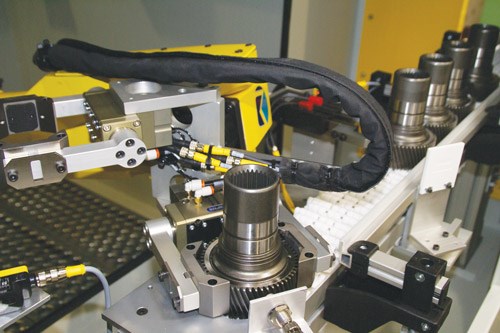Get Ready for Robotics
A weakened dollar combined with increased global demand has many factories scurrying to increase production and hiring. And while there is a larger pool of potential employees, it has always been difficult—especially for smaller firms—to find qualified people.
A weakened dollar combined with increased global demand has many factories scurrying to increase production and hiring. And while there is a larger pool of potential employees, it has always been difficult—especially for smaller firms—to find qualified people.
Manufacturing has always been cyclical, and forward-thinking companies should be using the current manufacturing environment to streamline, improve efficiencies and position themselves to be competitive during the next downturn. And while we can’t control the general manufacturing environment or the relative strength of the dollar, we can control manufacturing efficiencies, productivity and the cost of per piece labor.
Robotic part handling is one solution. Over the past decade, the price of robotic systems has been declining while the speed and technology available has increased. Cycle times less than 30 seconds have become commonplace. Well-engineered systems can often achieve cycle times less than 10 seconds. Additionally, robotic vision and force sensing have brought about a new generation of “intelligent” manufacturing cells.
The first step in determining whether robotic part handling is the right choice for a particular shop involves identifying operations that entail a great deal of manpower and that are repetitive in nature. While today’s robotic cells can “think” to a degree, a shop that’s new to robotics is better off starting with a relatively simple application to start with. Here are a few tips to keep in mind when researching robotic part handling.
Look for applications that are highly repetitive in nature. While an operator might be able to outpace a robotic cell in the short term, it is not possible to match robotic efficiencies in the long term. Typical manual efficiencies range from 65 to 75 percent. Robotic cell efficiencies are usually in the neighborhood of 90 to 95 percent.
Look for multi-shift work or jobs that are requiring overtime to be paid out. The more labor cost that can be replaced with a robotic cell per year, the faster the payback. A reasonable ROI for a robotic cell is typically in the 18 to 24 month range, while paybacks of 12 months or less are not unheard of.
Take into account the full cost of labor. This “burdened” rate includes any benefits that the company pays out as well as the employer’s share of payroll taxes. Typically, a burdened labor rate is approximately 30 percent higher than the nominal labor rate.
If this will be the first robotic cell, try to look for an application that requires minimal or no part change-over. If tooling change-over is necessary every couple of hours, or even every shift, the full benefits of automation will not be seen.
Additionally, an application should be “automation friendly,” meaning that it comes ready to be automated.
If a machine tool will be tended, an automation interface should be purchased from the machine tool builder. Alternately, there are companies that can provide aftermarket interfaces, or when all else fails, an electro-mechanical interface can be created.
Also, operator accessibility should be considered. Even a fully automated cell will require intervention on occasion for such things as making tool offsets, changing tools, and so on. While the cheapest and easiest solution is often to put the robot directly in front of equipment, this can create problems in the long run.
Another aspect to ponder is how the parts should be presented to the robot. If the parts come in bulk, they can probably be bulk fed, but if they are coming from a previous machining operation, a different method may need to be considered. Robot vision has developed to a point where it is relatively inexpensive to use a “fixtureless” conveyor that presents parts to a camera and feeds back part position and orientation to the robot. Part trays are another solution that can provide high part density, and hence, a long part queue in a small footprint.
While these tips should provide a good starting point from which to consider robotics, it is highly recommended to bring in the services of a skilled integrator. A shop’s staff knows its own application better than anyone from outside the business, but sometimes it helps to get a fresh set of eyes on the problem.
Performing a quick return on investment (ROI) calculation will give companies a good idea of which applications might be a good fit for a robotic cell.
Related Content
Pursuit of Parts Collector Spearheads New Enterprise
While searching for a small parts accumulator for Swiss-type lathes, this machine shop CEO not only found what he was looking for but also discovered how to become a distributor for the unique product.
Read MoreChuck Jaws Achieve 77% Weight Reduction Through 3D Printing
Alpha Precision Group (APG) has developed an innovative workholding design for faster spindle speeds through sinter-based additive manufacturing.
Read MoreUnattended Production Takes More Than the Most Capable CNC Machine
Process planning and reliable peripherals are key to successful lights-out manufacturing.
Read MoreReplace Repetitive Measurement With DIY Robotic Automation
After minimal training, a shop can learn how to use this robotic inspection system configured for a shopfloor application to supersede repetitive, time-consuming, high-mix gaging processes. It can then be redeployed for another application somewhere else in the facility.
Read MoreRead Next
Do You Have Single Points of Failure?
Plans need to be in place before a catastrophic event occurs.
Read More5 Aspects of PMTS I Appreciate
The three-day edition of the 2025 Precision Machining Technology Show kicks off at the start of April. I’ll be there, and here are some reasons why.
Read MoreA Tooling Workshop Worth a Visit
Marubeni Citizen-Cincom’s tooling and accessory workshop offers a chance to learn more about ancillary devices that can boost machining efficiency and capability.
Read More













.jpg;maxWidth=300;quality=90)









